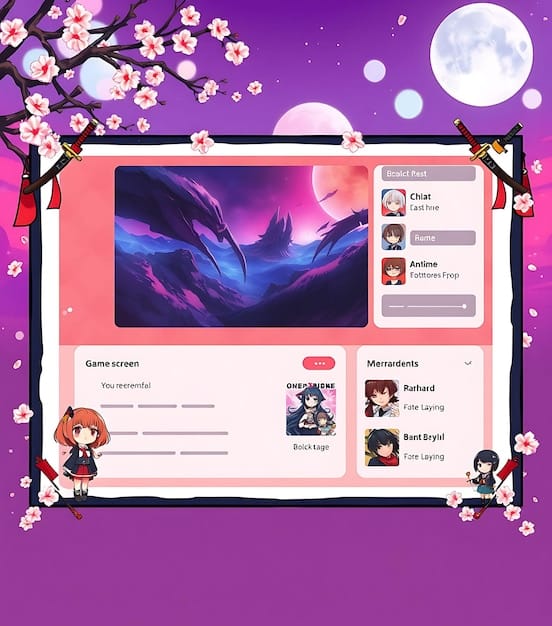K-Drama Fan Culture in the US: Online Communities & Viewing Habits

K-Drama Fan Culture in the US: How Online Communities Shape Viewing Habits and Discussions highlights how digital platforms enhance K-drama engagement. These communities allow fans to connect, share insights, and collectively influence viewing trends, fostering a global appreciation for Korean dramas.
The popularity of K-dramas has surged in the US, creating a vibrant and dedicated fanbase. But what truly fuels this phenomenon? It’s the online communities.
These digital spaces are more than just forums; they’re dynamic ecosystems where fans connect, discuss, and shape their viewing habits. Let’s delve into how K-Drama Fan Culture in the US: How Online Communities Shape Viewing Habits and Discussions.
Understanding the Rise of K-Drama Fan Culture in the US
The appeal of K-dramas goes beyond their engaging storylines and compelling characters. A significant factor driving their popularity is the active and involved fan base cultivated through online communities.
These platforms provide a space for enthusiasts to share their love for Korean dramas, creating a sense of belonging and shared passion.
The Role of Social Media
Social media platforms like Twitter, Instagram, and Facebook serve as central hubs for K-drama fans. These channels allow viewers to express their opinions, share fan-made content, and connect with like-minded individuals.
- Real-time Reactions: Fans live-tweet during episodes, sharing immediate reactions and creating trending topics.
- Fan Art and Edits: Talented fans create and share artwork, video edits, and memes, enhancing the viewing experience.
- Community Building: Groups and pages dedicated to specific dramas or actors foster a sense of belonging and allow fans to interact directly.
The accessibility and immediacy of social media amplify the reach and impact of K-drama fan culture, connecting viewers from diverse backgrounds and geographic locations.
In conclusion, the rise of K-Drama Fan Culture in the US is heavily influenced by social media. The community formed extends the viewing experience beyond just watching the show. It becomes a social event where fans interact, share, and create content.
How Online Communities Shape Viewing Habits
Online communities significantly influence what viewers choose to watch and how they engage with K-dramas. Recommendations, reviews, and discussions within these groups play a crucial role in shaping individual viewing decisions.
These communities provide a platform for fans to discover new dramas, learn about different genres, and seek recommendations based on shared preferences.

Recommendations and Reviews
Online forums and review sites offer a wealth of information for potential viewers. Fans share their opinions on various dramas, highlighting aspects such as plot, acting, and production quality.
These reviews often provide valuable insights that help viewers make informed decisions about what to watch.
Subtitles and Accessibility
Fan-made subtitles have played a significant role in making K-dramas accessible to a wider audience. Online communities often collaborate to provide accurate and timely translations, breaking down language barriers.
This collaborative effort ensures that more viewers can enjoy and appreciate Korean dramas, regardless of their language proficiency.
In conclusion, online communities dramatically mold viewing habits. The use of reviews, recommendations, and accessible subtitles has lead to the expansion of online discussions about K-Drama Fan Culture in the US.
Discussions and Interpretations of K-Dramas
One of the most significant aspects of K-Drama Fan Culture in the US: How Online Communities Shape Viewing Habits and Discussions, is the in-depth analysis and interpretation of dramas within online platforms.
These discussions go beyond simple opinions, delving into themes, symbolism, and character motivations.
Deep Dive Analysis
Fans engage in detailed discussions about plot twists, character arcs, and underlying messages. They often bring different perspectives and interpretations, enriching the overall viewing experience.
- Theme Exploration: Viewers dissect the central themes of the drama, such as love, family, social injustice, and personal growth.
- Symbolism and Metaphors: Fans analyze visual cues, recurring motifs, and symbolic elements that add depth and meaning to the narrative.
- Character Development: Discussions focus on the character’s motivations, relationships, and journeys, providing a deeper understanding of their actions and decisions.
This collaborative analysis allows viewers to gain a more profound appreciation for the artistry and complexity of K-dramas.
In conclusion, viewing K-dramas leads to analysis and discussion by fans. Online communities allow that to flourish and expand the overall experience for fans in the US.
The Impact on Korean Culture and Language Learning
The popularity of K-dramas in the US has sparked increased interest in Korean culture and language. Online communities often serve as resources for viewers who want to learn more about Korean traditions, customs, and language.
These platforms provide a supportive environment for language learners to practice their skills and connect with native speakers.

Language Exchange
Many online communities organize language exchange sessions, pairing native Korean speakers with K-drama fans who are learning the language. This provides a valuable opportunity for real-time practice and cultural exchange.
Participants can improve their speaking, listening, and comprehension skills while building friendships with people from different backgrounds.
Cultural Insights
Online forums and social media groups often share information about Korean culture, history, and society. This provides viewers with a deeper understanding of the context in which K-dramas are created.
Fans can learn about traditional customs, social etiquette, and historical events, adding a layer of cultural awareness to their viewing experience.
To summarize, online communities have spurred an interest in Korean language and culture in the US. Language Exchange provides valuable real-time practice and cultural exchange, further expanding the influence of K-Drama Fan Culture in the US.
Challenges and Criticisms of Online Fandom
While online communities offer numerous benefits, they also face challenges and criticisms. Issues such as toxicity, cyberbullying, and the spread of misinformation can negatively impact the fan experience.
It’s important for community members to be aware of these potential pitfalls and work towards creating a more positive and inclusive environment.
Toxicity and Negativity
Online fandoms can sometimes become breeding grounds for negativity and toxicity. Intense rivalries between fans of different actors or dramas can lead to heated arguments and personal attacks.
- Cyberbullying: Some individuals engage in cyberbullying, targeting those who hold unpopular opinions or express differing views.
- Spreading Rumors: False rumors and unsubstantiated claims can circulate rapidly within online communities, damaging reputations and creating unnecessary drama.
- Exclusionary Behavior: Newcomers may face exclusionary behavior from established members, hindering their ability to participate and feel welcome.
Community moderators and members have a responsibility to address these issues and create a more supportive and respectful environment.
In conclusion, while online communities allow fans to connect and enrich their experience, the environment is not always healthy. Toxicity and negativity can negatively impact the overall experience for everyone.
The Future of K-Drama Fan Culture in the US
As digital platforms continue to evolve, the future of K-Drama Fan Culture in the US: How Online Communities Shape Viewing Habits and Discussions will likely be shaped by emerging technologies and changing audience behaviors.
The ongoing development of interactive platforms, virtual reality experiences, and personalized content delivery will offer fans new and exciting ways to engage with their favorite dramas.
Interactive Platforms
The emergence of interactive platforms that allow viewers to directly participate in the narrative may revolutionize the viewing experience. Fans could vote on plot decisions, influence character development, and even appear as extras in virtual scenes.
This level of engagement would blur the lines between viewer and creator, fostering a more immersive and collaborative entertainment experience.
Virtual Reality Experiences
Virtual reality technology could transport viewers into the world of their favorite K-dramas, allowing them to interact with characters and explore virtual sets. Imagine visiting the iconic locations from “Crash Landing on You” or attending a concert with your favorite K-pop idols.
These immersive experiences would offer a new level of sensory engagement, further blurring the lines between reality and fiction.
Concluding, the future of K-Drama Fan Culture in the US is tied to advancing digital platforms. Interactive virtual reality experiences will provide increasingly amazing ways for fans to experience their favorite dramas.
| Key Point | Brief Description |
|---|---|
| 💬 Social Media Impact | Social platforms enhance K-drama engagement through real-time reactions and fan content. |
| 🎬 Viewing Habits | Online communities shape viewing choices via recommendations and accessible subtitles. |
| 🌍 Culture and Language | K-dramas spur interest in Korean culture and language through exchange programs. |
| 🛡️ Community Challenges | Online fandoms face issues like toxicity, requiring proactive moderation and respect. |
Frequently Asked Questions
Online communities greatly influence K-Drama Fan Culture in the US by serving as platforms for sharing opinions, creating content, and connecting with fellow fans, thus shaping collective viewing habits.
Popular platforms include Twitter, Reddit (r/KDRAMA), Soompi forums, and various Facebook groups. These sites host discussions, fan art, and real-time episode reactions.
Fans contribute by creating subtitles, sharing translated content, and promoting dramas through social media. This collective effort breaks down language barriers and increases the visibility of K-dramas.
Discussions range from in-depth analysis of plot and characters to sharing personal experiences related to the drama. Fans also explore themes, cultural nuances, and speculate on future episodes.
Yes, challenges include toxic fan behavior, cyberbullying, and the spread of misinformation. However, many communities actively moderate and promote a positive environment for fans.
Conclusion
In conclusion, K-Drama Fan Culture in the US: How Online Communities Shape Viewing Habits and Discussions highlights the deep connection that US viewers have with Korean dramas and how online communities enhance that bond. These platforms boost the engagement.
As technology evolves, these digital interactions will continue to develop, providing new ways for fans to connect with each other and their favorite K-dramas.





